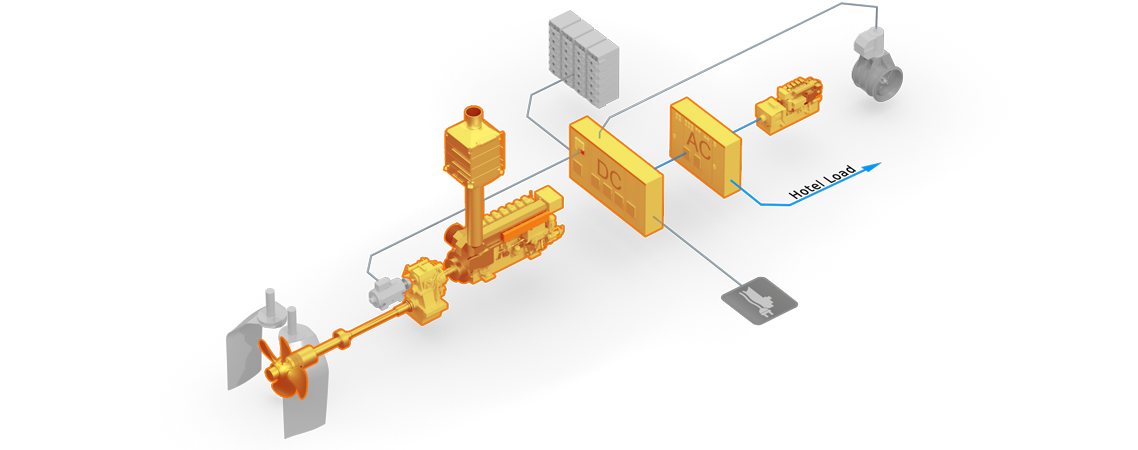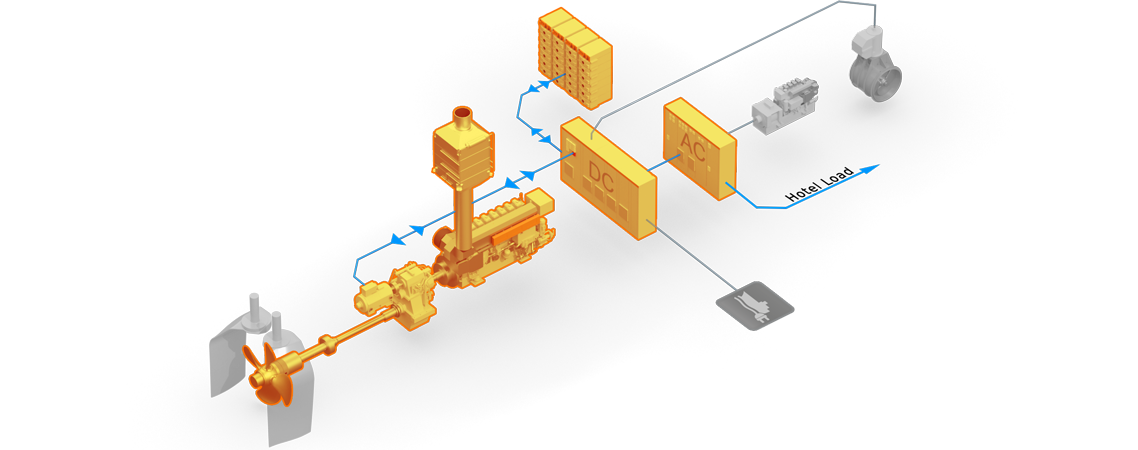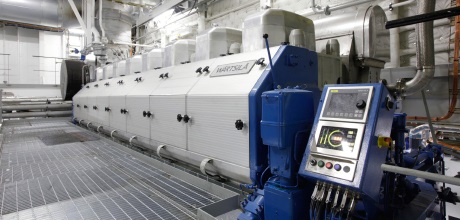

Diverse operations require flexible systems to maximise efficiency
Small and medium gas carriers generally transport liquid natural gas (LNG) or liquid petroleum gas (LPG), or other chemical products in gaseous form. Some vessel designs may be tailored for bunkering or ship-to-ship operations. Vessels in this size class need to be adaptable for varying voyage distances, loading conditions, and sailing speeds as well as varying power requirements for cargo handling and port entry and exit operations. Vessel CAPEX and OPEX are crucial to secure profitable and competitive business.
Gas carriers sail under variable cargo loads and with varying operational profiles, meaning propulsive and electrical power requirements can vary greatly. As a result, owners must balance the need to minimise a vessel’s Energy Efficiency Design Index (EEDI) with the need to ensure that installed propulsive power is sufficient to cope with adverse weather conditions as required by the IMO’s MARPOL Convention.
Vessels carrying hazardous or pollutant goods are usually required to have backup steering and navigational systems in case of failure. Small and medium gas carriers also often sail in challenging waters such as channels or fjords, making a reliable propulsion system, effective steering capability and excellent manoeuvrability a must. They may also be sailing in environmentally sensitive areas with strict emission and underwater noise limits. In addition, port operations may take place close to urban areas where even stricter local environmental regulations apply.
Integrated solution for small and medium gas carriers
Hover or click on the symbols to reveal more information on the six parts of the integrated solution.
Small gas carrier DF-DE
Small gas carrier DF-DM
Medium gas carrier
Small gas carrier DF-DE
Wärtsilä dual fuel-diesel electric (DF-DE) propulsion system
Emission reduction and operational flexibility are the main drivers behind the development of Wärtsilä propulsion systems for small and medium gas carriers. These highly adaptable, customised propulsion systems can be enhanced with a variety of advanced functionalities according to the intended operational profile of the vessel in question.
A great option for this vessel type is a diesel-electric hybrid propulsion system that includes fuel-flexible medium-speed gensets, a switchboard and a propulsion motor connected to steerable aft thrusters, a forward tunnel thruster and a battery-based energy storage system (ESS). An integrated Energy Management System (EMS) ensures all the elements work seamlessly together, optimising energy flows to achieve the best performance in all operational modes.
System operational modes for small gas carrier DF-DE
Small gas carrier DF-DE
Expand all
Small gas carrier DF-DM
Wärtsilä dual fuel-diesel mechanical (DF-DM) propulsion system
Emission reduction and operational flexibility are the main drivers behind the development of Wärtsilä propulsion systems for small and medium gas carriers. These highly adaptable, customised propulsion systems can be enhanced with a variety of advanced functionalities according to the intended operational profile of the vessel in question.
A great option for this vessel type is a hybrid propulsion system that includes a fuel-flexible medium-speed main engine, a geared propeller system, a shaft motor/generator (PTO/PTI) and a battery-based energy storage system (ESS) as well as an auxiliary genset. An integrated Energy Management System (EMS) ensures all the elements work seamlessly together, optimising energy flows to achieve the best performance in all operational modes.
System operational modes for small gas carrier DF-DM
Small gas carrier DF-DM
Expand all
Medium gas carrier
The Wärtsilä propulsion system for this vessel type has a main engine mechanically connected to a CPP through a one-step gearbox with PTO/PTI connection. This helps owners to balance the need to minimise a vessel’s Energy Efficiency Design Index (EEDI) and comply with the IMO’s MARPOL Convention while ensuring that installed propulsive power is sufficient to cope with adverse weather conditions. The Wärtsilä ProTouch Propulsion Control System offers a user-friendly interface and advanced features such as EcoControl. A GATE RUDDER™ can be added for superior efficiency and manoeuvrability and a bow thruster to further enhance manoeuvrability.
System operational modes for medium gas carrier
Medium gas carrier
Expand all
Essential solutions for small and medium gas carriers
Hand-picked press releases
Wärtsilä and Chevron Shipping partner to lower methane emissions on LNG Carriers
Technology group Wärtsilä, in partnership with Chevron Shipping Company LLC plans to convert one engine on six of Chevron Transport Corporation Ltd.’s LNG Carriers from dual-fuel (DF) to spark gas (SG) operation. The conversions are intended to reduce greenhouse gas emissions by lowering methane slip in support of Chevron Shipping’s broader efforts to reduce the carbon intensity of its operations. This marine industry first was made possible after two years of collaboration between the companies. The order for the first two vessels was booked by Wärtsilä in Q3 2024.
LNG, when burned as a fuel, results in small amounts of methane that may not fully combust leading to methane escaping into the atmosphere, referred to as methane slip. Methane exists in the atmosphere for a shorter time than CO₂ but traps approximately 25–30* times more heat over a 100-year period. Addressing methane emissions is a key part of lowering carbon intensity. Wärtsilä’s 50DF to SG conversion project is designed to modify the engines in service to operate as SG, using spark ignition versus diesel pilot fuel to initiate combustion. This enables a more optimised combustion process, thereby reducing the methane slip and improving efficiency.
"Chevron Shipping aims to reduce methane emissions intensity of our LNG fleet in support of a lower carbon future," says Barbara Pickering, President of Chevron Shipping. "We are pleased to collaborate with Wärtsilä in this industry first. This demonstrates steps we are taking to reduce the carbon intensity of marine transportation."
"This innovative project represents a notable step forward on the road to advancing lower carbon fleets," said Roger Holm, President of Wärtsilä Marine & Executive Vice President at Wärtsilä Corporation. “Wärtsilä has an extensive track-record in reducing methane slip from LNG-fuelled engines, not only as newbuild solutions, but also through retrofitting existing installations.”
This new technology complements Wärtsilä's extensive portfolio of solutions aimed at reducing methane emissions from vessels. With nearly three decades of experience in LNG technology, Wärtsilä is providing market leading performance both with the dual fuel flexibility provided by the DF engine, as well as with the single fuel SG engine.
Media contacts:
Isabella Alder
Positioning and Strategic Communications Manager, Wärtsilä Marine
Tel: +44 (0) 7792 681 757
marine.media@wartsila.com
Christine Dobbyn
External Affairs Advisor, Chevron
Tel: +1 281-906-1499
christinedobbyn@chevron.com
Image caption: Wärtsilä, in partnership with Chevron Shipping Company LLC plans to convert one engine on six of Chevron Transport Corporation Ltd.’s LNG Carriers from dual-fuel (DF) to spark gas (SG) operation. © Chevron Shipping
Use of the image(s) is allowed only in connection with the contents of this press release. Wärtsilä images are available at https://www.wartsila.com/media/image-bank.
About Wärtsilä
Wärtsilä is a global leader in innovative technologies and lifecycle solutions for the marine and energy markets. We emphasise innovation in sustainable technology and services to help our customers continuously improve environmental and economic performance. Our dedicated and passionate team of 17,800 professionals in more than 280 locations in 79 countries shape the decarbonisation transformation of our industries across the globe. In 2023, Wärtsilä’s net sales totalled EUR 6.0 billion. Wärtsilä is listed on Nasdaq Helsinki.
www.wartsila.com
About Wärtsilä Marine
Wärtsilä Marine is a global pioneer in power, propulsion, and lifecycle solutions for the marine market. We develop industry-leading technologies, advancing maritime's transition to new fuels. We support building an end-to-end digital ecosystem where all vessels and ports are connected. Ultimately, Wärtsilä Marine is driving the shipping industry forward on its journey towards a decarbonised and sustainable future through our broad portfolio of engines, propulsion systems, hybrid technology, exhaust treatment, shaft line solutions and digital technologies, as well as integrated powertrain systems. Our offering, which is underpinned by our performance-based agreements, upgrades, lifecycle solutions, decarbonisation services, as well as an unrivalled global network of maritime expertise, delivers the efficiency, reliability, safety, and environmental performance needed to support a safe and sustainable future for our customers, our communities, and our planet.
www.wartsila.com/marine
About Chevron
Chevron is one of the world’s leading integrated energy companies. We believe affordable, reliable and ever cleaner energy is essential to enabling human progress. Chevron produces crude oil and natural gas; manufactures transportation fuels, lubricants, petrochemicals and additives; and develops technologies that enhance our business and the industry. We aim to grow our oil and gas business, lower the carbon intensity of our operations and grow lower carbon businesses in renewable fuels, carbon capture and offsets, hydrogen and other emerging technologies. More information about Chevron is available at www.chevron.com.



















